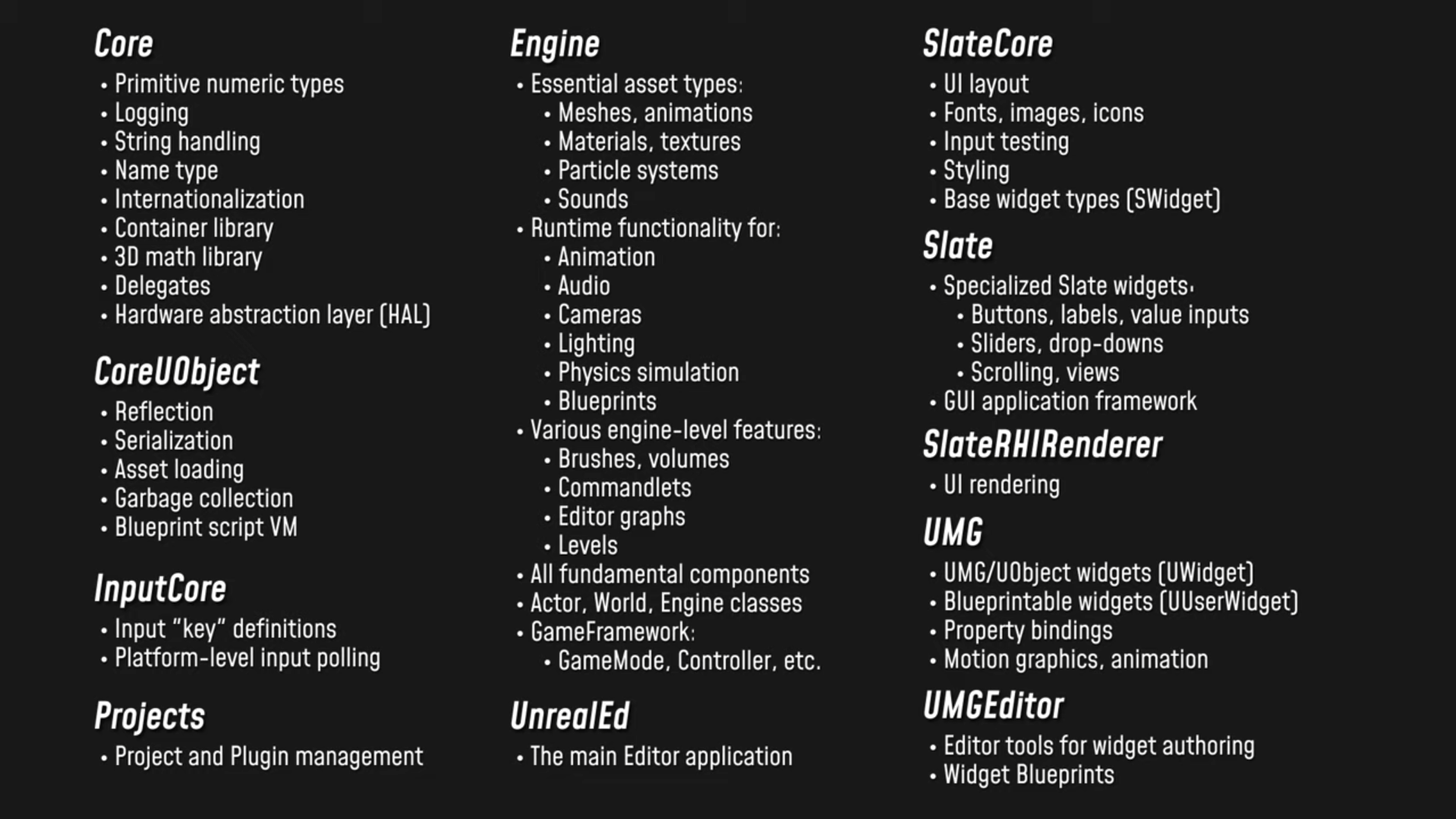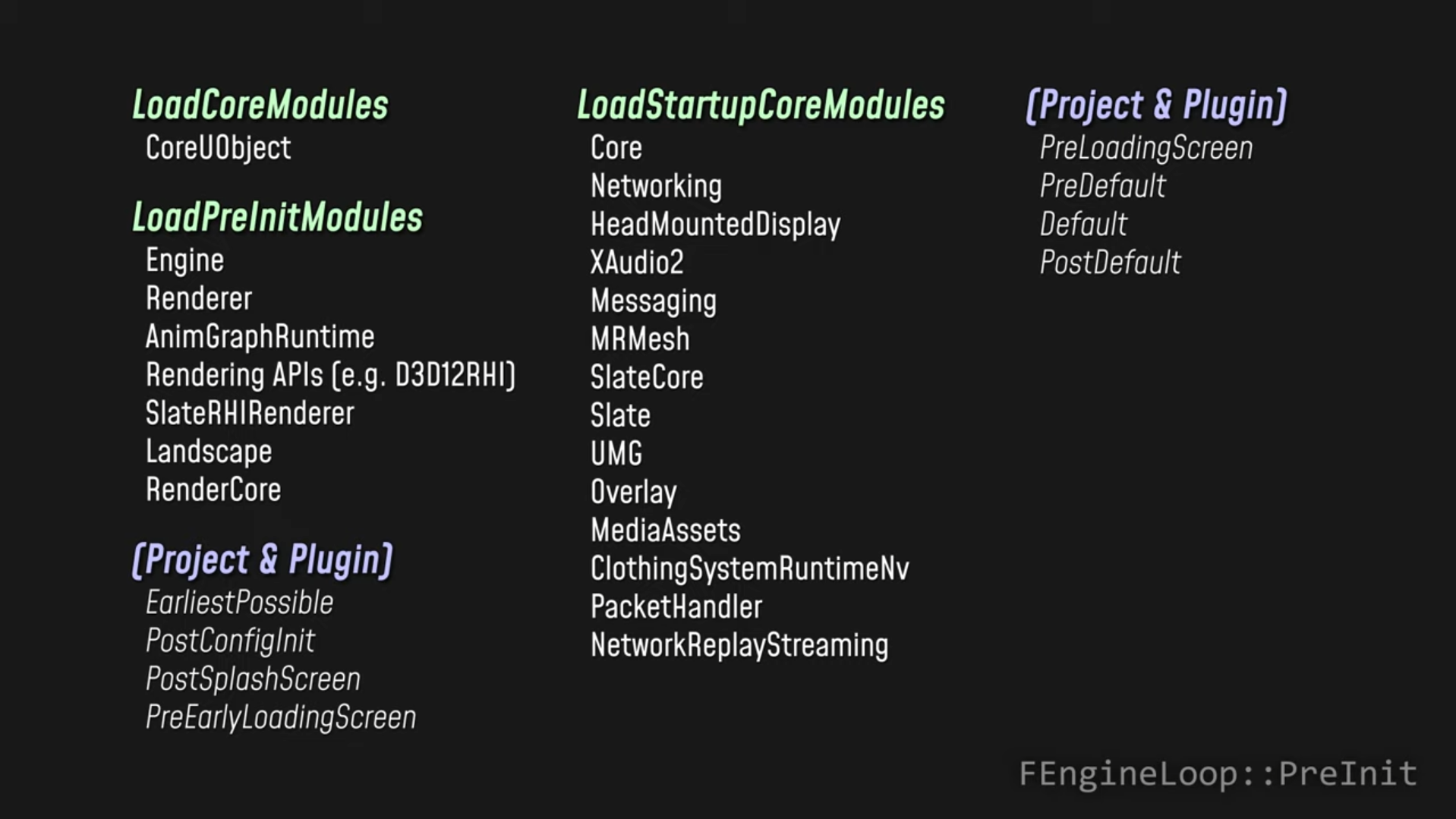UE5的引擎初始化流程
首先跟着UE的官方文档[1]获取到UE的源代码,然后在参考GitHub上repo的readme,将UE引擎从源码build出来。以Windows平台为例,先找到引擎的入口函数:
c++
int32 WINAPI WinMain(_In_ HINSTANCE hInInstance, _In_opt_ HINSTANCE hPrevInstance, _In_ char* pCmdLine, _In_ int32 nCmdShow)
{
int32 Result = LaunchWindowsStartup(hInInstance, hPrevInstance, pCmdLine, nCmdShow, nullptr);
LaunchWindowsShutdown();
return Result;
}可以看到入口函数很简单,就分为startup和shutdown两部分,那么想必引擎的主循环是在这个startup里。startup函数主要负责初始化各种调用环境,解析命令行参数,调用真正的main函数:
c++
LAUNCH_API int32 LaunchWindowsStartup( HINSTANCE hInInstance, HINSTANCE hPrevInstance, char*, int32 nCmdShow, const TCHAR* CmdLine )
{
// Setup common Windows settings
SetupWindowsEnvironment();
int32 ErrorLevel = 0;
hInstance = hInInstance;
if (!CmdLine)
{
CmdLine = ::GetCommandLineW();
// Attempt to process the command-line arguments using the standard Windows implementation
// (This ensures behavior parity with other platforms where argc and argv are used.)
if ( ProcessCommandLine() )
{
CmdLine = *GSavedCommandLine;
}
}
ErrorLevel = GuardedMain( CmdLine );
return ErrorLevel;
}简化后的main函数如下:
c++
int32 GuardedMain( const TCHAR* CmdLine )
{
// Super early init code. DO NOT MOVE THIS ANYWHERE ELSE!
FCoreDelegates::GetPreMainInitDelegate().Broadcast();
// make sure GEngineLoop::Exit() is always called.
struct EngineLoopCleanupGuard
{
~EngineLoopCleanupGuard()
{
// Don't shut down the engine on scope exit when we are running embedded
// because the outer application will take care of that.
if (!GUELibraryOverrideSettings.bIsEmbedded)
{
EngineExit();
}
}
} CleanupGuard;
int32 ErrorLevel = EnginePreInit( CmdLine );
// exit if PreInit failed.
if ( ErrorLevel != 0 || IsEngineExitRequested() )
{
return ErrorLevel;
}
#if WITH_EDITOR
if (GIsEditor)
{
ErrorLevel = EditorInit(GEngineLoop);
}
else
#endif
{
ErrorLevel = EngineInit();
}
// Don't tick if we're running an embedded engine - we rely on the outer
// application ticking us instead.
if (!GUELibraryOverrideSettings.bIsEmbedded)
{
while( !IsEngineExitRequested() )
{
EngineTick();
}
}
#if WITH_EDITOR
if( GIsEditor )
{
EditorExit();
}
#endif
return ErrorLevel;
}梳理一下大体的逻辑,在一切初始化逻辑开始之前,函数会先把这个消息广播出去,如果有更早需要执行的逻辑,可以注册到这个委托上。另外,为了保证引擎的退出逻辑一定会被调用到,UE在这里定义了一个局部的struct,这个struct定义了一个析构函数,析构函数的实现就是调用引擎的退出逻辑。有了这个局部struct,再定义一个局部的对象,这个对象不是动态分配的,那么C++会保证它离开作用域时就会销毁它,从而调用到引擎的退出逻辑。这也是C++ RAII的常见做法了。
再往下,可以发现引擎的初始化分为PreInit和Init两个步骤。Init会根据是否是Editor环境,调用不同的逻辑。在初始化完成后,就进入到了引擎的主循环。
顺便一提,PreInit,Init,Tick,Exit都是简单的包装函数,它们的实现就是调用全局变量GEngineLoop的相应接口。
c++
int32 EngineInit()
{
int32 ErrorLevel = GEngineLoop.Init();
return( ErrorLevel );
}
LAUNCH_API void EngineTick( void )
{
GEngineLoop.Tick();
}
LAUNCH_API void EngineExit( void )
{
// Make sure this is set
RequestEngineExit(TEXT("EngineExit() was called"));
GEngineLoop.Exit();
}PreInit初始化了各种底层模块[4],非常繁多。

除此之外,还完成了许多模块的加载:

Init阶段,UE会根据是否为editor环境调用EditorInit或者EngineInit。而EditorInit本身的实现里就是包含EngineInit的。Init简化后的版本如下。
c++
int32 FEngineLoop::Init()
{
UClass* EngineClass = nullptr;
if( !GIsEditor )
{
// We're the game.
FString GameEngineClassName;
GConfig->GetString(TEXT("/Script/Engine.Engine"), TEXT("GameEngine"), GameEngineClassName, GEngineIni);
EngineClass = StaticLoadClass( UGameEngine::StaticClass(), nullptr, *GameEngineClassName);
GEngine = NewObject<UEngine>(GetTransientPackage(), EngineClass);
}
else
{
#if WITH_EDITOR
// We're UnrealEd.
FString UnrealEdEngineClassName;
GConfig->GetString(TEXT("/Script/Engine.Engine"), TEXT("UnrealEdEngine"), UnrealEdEngineClassName, GEngineIni);
EngineClass = StaticLoadClass(UUnrealEdEngine::StaticClass(), nullptr, *UnrealEdEngineClassName);
GEngine = GEditor = GUnrealEd = NewObject<UUnrealEdEngine>(GetTransientPackage(), EngineClass);
#endif
}
GEngine->ParseCommandline();
GEngine->Init(this);
FCoreDelegates::OnPostEngineInit.Broadcast();
if (!IProjectManager::Get().LoadModulesForProject(ELoadingPhase::PostEngineInit) || !IPluginManager::Get().LoadModulesForEnabledPlugins(ELoadingPhase::PostEngineInit))
{
RequestEngineExit(TEXT("One or more modules failed PostEngineInit"));
return 1;
}
// Call module loading phases completion callbacks
SetEngineStartupModuleLoadingComplete();
GEngine->Start();
GIsRunning = true;
FCoreDelegates::OnFEngineLoopInitComplete.Broadcast();
return 0;
}Init阶段主要做了如下的事情[3]:
- 根据当前是否为编辑器环境,检查引擎配置文件以确定应该使用哪个GameEngine类;
- 然后创建该类的一个实例并将其作为全局UEngine实例。也就是GEngine;
- 创建之后,进行初始化,完成时会触发一个全局委托;
- 加载已配置为延迟加载的任何项目或插件模块;
- 加载完成后,再触发一个完成的回调;
- 正式启动引擎;
- 发送引擎启动的委托。
自此,引擎的初始化流程就宣告结束了,后面就进入到了tick的阶段。
Reference
1\] [下载虚幻引擎源代码](https://dev.epicgames.com/documentation/en-us/unreal-engine/downloading-unreal-engine-source-code) \[2\] [从零开始手敲次世代游戏引擎(五)](https://zhuanlan.zhihu.com/p/28619982) \[3\] [UE5 -- 引擎运行流程(从main到BeginPlay)](https://zhuanlan.zhihu.com/p/577433224) \[4\] [The Unreal Engine Game Framework: From int main() to BeginPlay](https://www.youtube.com/watch?v=IaU2Hue-ApI)